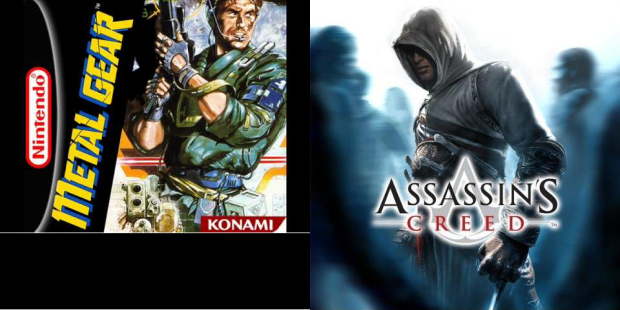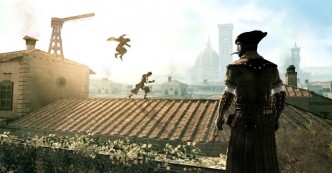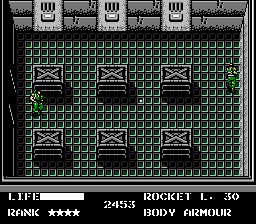
Insert Currency
Insert Currency: Assassin’s Creed – Tactical Espionage Action
In part one we talked about the ways in which Assassin’s Creed sprouted legs and learned to leap from the original Prince of Persia. In this second part we will examine how it came to crawl, duck, fall into bales of hay, and other generally suspicious activities. The roots of the stealth genre can be found all the way back in 1987, hiding under a box titled Metal Gear.
A great slice of the gaming community has a taste for destruction. There is an excitement and pride that oozes out of a game developer talking about their new physics engine, but these aren’t magical contraptions that consume gasoline and sputter Einstein’s theories out the exhaust. A physics engine almost always serves a single purpose, making sure that the bits you just sent to kingdom come spray out in the most satisfying and realistic manner modern man can conjure up. Amidst this crowd of digital-blood thirsty hordes are those that would see their enemies taken apart in a more subtle manner. These groups are by no means exclusive but it is the latter that Assassin’s Creed appeals to, a group that was first given a voice with the release of Metal Gear in 1987.
Up until the release of Metal Gear, combat-oriented games were a driving market force as epitomized by classics such as Renegade and Contra. For these titles, combat was not only present, but the majority of the gameplay. Contra without combat is like a tablet computer without internet; it works, but really you are walking around like an idiot. Metal Gear’s radical break with these came in the form of stealth and is what has given the series its longevity. The closest Contra’s come to having this mechanic was the ability to jump over an enemy that was power-walked headlong in your direction, which is stealthy in much the same way that drunkenly falling off your back deck is like landing a nuclear powered science car on Mars. If that counted then I would be a Contra ninja and the human equivalent of NASA.
In Metal Gear the impetus is on the player is to advance through enemy compounds unseen, a development that creates a much more cerebral experience than its predecessors. Instead of a focus on seizure-inspired button mashing, the player must observe and memorize enemy movements, and then craft a route around them. It plays like a peeping-tom simulator, if you are spotted once you are in trouble, but if spotted again you will be hunted by a large, mean, and organized group of heavily armed men. In spite of this being an advancement for video games, and would-be predator training, it actually harkens back to older analog strategy games such as chess.
The difference between the Sport of Kings and the sport of criminals (at least according to the media) is the use of critical thinking. Down-to-forward B, however satisfying and fun, has always been an exercise in hand-eye coordination and dexterity, never an intellectual endeavor. If the art was stripped away from Metal Gear, a game of pattern recognition and complex maze solving is revealed. It was certainly nowhere near the intellectual heavyweight of chess, but made tentative steps towards that arena.
Couched in the trapping of modern storytelling, Assassin’s Creed has honed those core stealth mechanics to a fine dagger-point. Instead of every non-player character on-screen being hostile, the protagonist must rely on the anonymity of crowds to blend in and hide in plain sight. Rooftops became reconnaissance vantage points as well as another passage with which to break away from the view of those that would give chase. Essentially the challenge is the same, pattern & maze, only more complicated by adding the open level design and platformer elements of Prince of Persia. When your maze is an entire town, your road all of the roofs, and the pattern based on the shifting priorities of guards, the challenge faced is no longer simple. Assassin’s Creed, bred from an earlier generation, requires a level of creativity new to the genre.
